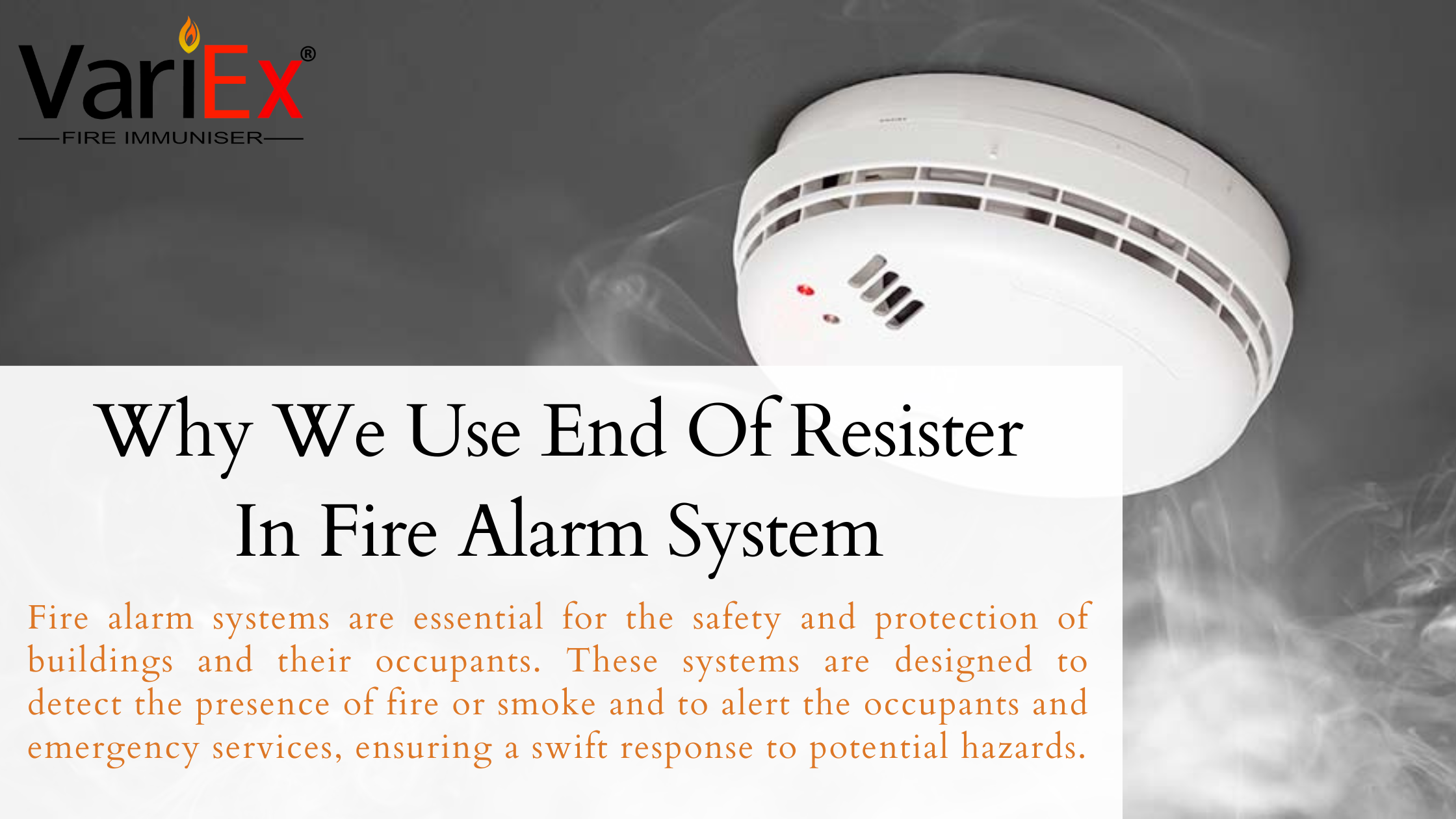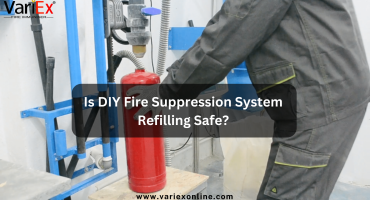![]()
Fire Immuniser
+91-7829629111
Email: info@variex.in
Varistor Technologies Pvt. Ltd.
Block-1, First Floor, Ardente Office One, Hoodi Circle, ITPL Main Road, Bengaluru, Karnataka 560048, IN
Why We Use End Of Resister In Fire Alarm System
Why We Use End Of Resister In Fire Alarm System
Fire alarm systems are essential for the safety and protection of buildings and their occupants. These systems are designed to detect the presence of fire or smoke and to alert the occupants and emergency services, ensuring a swift response to potential hazards. A key component in these systems is the End-of-Line (EOL) resistor. This component, though small, plays a crucial role in maintaining the integrity and functionality of the fire alarm system. In this comprehensive discussion, we will delve into the reasons for using EOL resistors in fire alarm systems, exploring their historical development, technical functions, practical applications, and their importance in modern safety protocols.
Historical Context
The concept of fire detection and alarm systems dates back to ancient civilizations, where rudimentary methods like fire watchmen and basic smoke detection were used. However, it wasn't until the 19th and 20th centuries that technological advancements led to the development of more sophisticated fire alarm systems. Early electrical fire alarm systems were prone to faults and malfunctions, often resulting in false alarms or failure to detect real fires. The introduction of EOL resistors marked a significant improvement in the reliability and accuracy of these systems.
EOL resistors were introduced as a solution to the problem of monitoring the integrity of the electrical circuits in fire alarm systems. By ensuring that the electrical loop was complete, these resistors enabled continuous supervision of the system, allowing for the detection of faults such as open circuits, short circuits, and ground faults. This development greatly enhanced the reliability of fire alarm systems, making them more effective in protecting lives and property.
Technical Functions of EOL Resistors
The primary function of an EOL resistor is to monitor the integrity of the circuit in a fire alarm system. This is achieved by placing the resistor at the end of the wiring loop, completing the electrical circuit. The control panel of the fire alarm system continuously monitors the resistance of the circuit, which should match the resistance value of the EOL resistor. Any deviation from this expected value indicates a potential issue, prompting the system to signal a trouble condition.
Here are the key technical functions of EOL resistors:
Open Circuit Detection:
- An open circuit occurs when there is a break in the wiring or a disconnection of a device. This disrupts the flow of electricity, causing an increase in resistance. The EOL resistor helps the control panel detect this increase, signaling a trouble condition and indicating that the circuit needs to be inspected and repaired.
Short Circuit Detection:
- A short circuit happens when two wires touch, creating an unintended path for electricity. This results in a decrease in resistance. The EOL resistor ensures that such changes in resistance are noticeable to the control panel, allowing it to detect the short circuit and signal a trouble condition.
Ground Fault Detection:
- A ground fault occurs when a wire comes into contact with a grounded surface, causing a partial short circuit. This can be detected by the EOL resistor, which helps the control panel identify the fault and signal a trouble condition.
Device Supervision:
- The EOL resistor enables continuous supervision of all devices connected to the fire alarm system, such as smoke detectors, heat detectors, and manual call points. This ensures that any faults in the devices are quickly detected and addressed, maintaining the system's overall reliability.
Practical Applications of EOL Resistors
EOL resistors are used in various types of fire alarm systems, including conventional, addressable, and hybrid systems. Each type of system has its own specific requirements and applications for EOL resistors.
Conventional Fire Alarm Systems:
- In conventional fire alarm systems, the building is divided into zones, each with its own set of detectors and alarm devices. The EOL resistor is placed at the end of each zone's wiring loop. This allows the control panel to monitor the integrity of each zone independently, ensuring that any faults are quickly detected and addressed.
Addressable Fire Alarm Systems:
- Addressable fire alarm systems provide more precise monitoring and control by assigning a unique address to each device. The EOL resistor is still used in these systems, typically at the end of each device loop. The control panel can then monitor the resistance at each address, ensuring that the entire system is functioning correctly and identifying any faults with greater accuracy.
Hybrid Fire Alarm Systems:
- Hybrid fire alarm systems combine features of both conventional and addressable systems. EOL resistors are used in these systems to monitor the integrity of both the conventional zones and the addressable loops, providing a comprehensive solution for building safety.
Importance of EOL Resistors in Modern Safety Protocols
The use of EOL resistors in fire alarm systems is crucial for several reasons, all of which contribute to the overall safety and effectiveness of these systems.
Enhanced Reliability:
- EOL resistors significantly enhance the reliability of fire alarm systems by ensuring continuous monitoring of the wiring and devices. This reduces the likelihood of false alarms and system failures, providing greater confidence in the system's ability to detect and respond to real fires.
Compliance with Safety Standards:
- Fire alarm systems must comply with stringent safety standards and regulations, such as those set by the National Fire Protection Association (NFPA) and other regulatory bodies. The use of EOL resistors helps systems meet these standards by ensuring comprehensive monitoring and prompt detection of faults.
Improved Maintenance and Troubleshooting:
- By providing continuous supervision and fault detection, EOL resistors make it easier to maintain and troubleshoot fire alarm systems. When a fault is detected, the control panel can pinpoint the location of the issue more accurately, reducing the time and effort required to identify and fix problems.
Increased Safety for Occupants:
- The primary goal of any fire alarm system is to protect the occupants of a building. EOL resistors play a vital role in achieving this goal by ensuring that the system remains fully operational at all times. This ensures that any potential fires are detected and responded to promptly, minimizing the risk to human life.
Detailed Explanation of EOL Resistor Functions
To fully understand the importance of EOL resistors, it is beneficial to delve deeper into the specific functions they perform within a fire alarm system. This section will provide a more detailed explanation of how EOL resistors help detect and signal various types of faults.
Open Circuit Detection:
- When there is a break in the wiring or a device is disconnected, it creates an open circuit. This means that the electrical current cannot complete its path through the circuit, resulting in an increase in resistance. The EOL resistor, placed at the end of the circuit, helps the control panel detect this increase in resistance. The control panel is programmed to recognize the expected resistance value of the EOL resistor. If the resistance exceeds this value, the panel signals a trouble condition, alerting maintenance personnel to inspect and repair the circuit.
Short Circuit Detection:
- A short circuit occurs when two wires come into contact, creating an unintended path for the electrical current. This causes a decrease in resistance, as the current can bypass part of the circuit. The EOL resistor helps the control panel detect this change in resistance. By monitoring the expected resistance value, the control panel can identify when a short circuit has occurred and signal a trouble condition. This alerts maintenance personnel to the presence of a short circuit, allowing them to locate and fix the issue.
Ground Fault Detection:
- Ground faults occur when a wire comes into contact with a grounded surface, creating a partial short circuit. This can cause intermittent faults and reduced sensitivity in the fire alarm system. The EOL resistor helps the control panel detect ground faults by monitoring changes in resistance. When a ground fault is detected, the control panel signals a trouble condition, prompting maintenance personnel to inspect the wiring and address the issue.
Device Supervision:
- Fire alarm systems rely on various devices, such as smoke detectors, heat detectors, and manual call points, to detect the presence of fire or smoke. The EOL resistor enables continuous supervision of these devices by ensuring that the control panel can monitor the resistance of the entire circuit. If a device malfunctions or is disconnected, the resulting change in resistance is detected by the control panel, which signals a trouble condition. This ensures that any issues with the devices are quickly identified and addressed, maintaining the system's overall reliability.
Practical Considerations for Implementing EOL Resistors
When designing and installing fire alarm systems, there are several practical considerations to keep in mind regarding the use of EOL resistors. These considerations include selecting the appropriate resistor value, proper placement of the resistor, and ensuring compliance with relevant standards and regulations.
Selecting the Appropriate Resistor Value:
- The value of the EOL resistor must be carefully selected to match the specifications of the fire alarm system. The resistance value is typically provided by the manufacturer of the control panel and must be adhered to for proper system operation. Using an incorrect resistor value can result in false alarms or failure to detect real faults, compromising the reliability of the system.
Proper Placement of the Resistor:
- The EOL resistor must be placed at the end of the wiring loop, completing the circuit. This placement is crucial for the control panel to accurately monitor the integrity of the circuit. The resistor should be securely connected and protected from physical damage or environmental factors that could affect its resistance value.
Ensuring Compliance with Standards and Regulations:
- Fire alarm systems must comply with various safety standards and regulations, such as those set by the NFPA, Underwriters Laboratories (UL), and local building codes. These standards often include specific requirements for the use of EOL resistors. It is important to ensure that the system design and installation adhere to these requirements to achieve compliance and ensure the safety of the building and its occupants.
Testing and Maintenance:
- Regular testing and maintenance of the fire alarm system, including the EOL resistors, are essential for ensuring continued reliability and effectiveness. This includes periodic inspections to verify the integrity of the wiring and devices, as well as testing the resistance values to ensure they match the expected values. Any faults or discrepancies should be promptly addressed to maintain the system's performance.
Case Studies and Examples
To illustrate the importance of EOL resistors in fire alarm systems, consider the following case studies and examples:
Case Study 1: Commercial Office Building:
- In a large commercial office building, the fire alarm system is divided into multiple zones, each with its own set of detectors and alarm devices. The EOL resistors are placed at the end of each zone's wiring loop. During a routine inspection, the control panel signals a trouble condition in one of the zones. Upon investigation, it is discovered that a wire had been accidentally cut during maintenance work, creating an open circuit. The EOL resistor helped detect this fault, allowing maintenance personnel to promptly repair the wiring and restore the integrity of the system.
Case Study 2: Residential Apartment Complex:
- In a residential apartment complex, an addressable fire alarm system is used to provide precise monitoring of each device. The EOL resistors are placed at the end of each device loop. One day, the control panel signals a trouble condition for a specific address. Upon inspection, it is found that a smoke detector had been tampered with and disconnected by a tenant. The EOL resistor helped detect the disconnection, allowing maintenance personnel to address the issue and ensure the system's continued reliability.
Case Study 3: Industrial Facility:
- In an industrial facility, a hybrid fire alarm system is used to monitor both conventional zones and addressable loops. The EOL resistors are placed at the end of each zone and loop. During a routine test, the control panel signals a ground fault condition. Upon investigation, it is found that a wire had come into contact with a grounded metal surface due to wear and tear. The EOL resistor helped detect this ground fault, allowing maintenance personnel to repair the wiring and prevent potential issues with the system's sensitivity.
Conclusion
End-of-Line resistors are a vital component in fire alarm systems, playing a crucial role in ensuring the integrity and functionality of the system. By providing continuous monitoring of the wiring and devices, EOL resistors help detect and signal faults such as open circuits, short circuits, and ground faults. This enhances the reliability of fire alarm systems, ensures compliance with safety standards, and improves maintenance and troubleshooting processes.
The historical development and practical applications of EOL resistors highlight their importance in modern safety protocols. By understanding the technical functions and practical considerations for implementing EOL resistors, we can ensure that fire alarm systems remain effective in protecting lives and property. Regular testing and maintenance, along with adherence to relevant standards and regulations, are essential for maintaining the performance and reliability of these systems.
In summary, the use of End-of-Line resistors in fire alarm systems is a critical practice that enhances safety, reliability, and compliance. By ensuring continuous supervision and prompt detection of faults, EOL resistors help create a safer environment for building occupants and provide greater confidence in the effectiveness of fire alarm systems.
Frequently Asked Questions
An EOL resistor is a component used in fire alarm systems to monitor the integrity of the circuit. It is placed at the end of the wiring loop to ensure continuous supervision and fault detection.
EOL resistors are important because they help detect and signal open circuits, short circuits, and ground faults. This ensures the reliability and effectiveness of the fire alarm system in detecting and responding to fires.
The EOL resistor is placed at the end of the wiring loop, completing the circuit. This placement allows the control panel to monitor the entire circuit for any faults.
If the EOL resistor is not installed correctly, the fire alarm system may not be able to detect faults accurately. This can result in false alarms or failure to detect real issues, compromising the reliability of the system.
An open circuit occurs when there is a break in the wiring. The EOL resistor helps the control panel detect the increase in resistance caused by this break, signaling a trouble condition.
Final Say
At VariEx.in and VariexOnline.com, we specialize in supplying and installing top-quality fire fighting systems and equipment. From fire extinguishers to advanced suppression systems, we offer comprehensive solutions tailored to your needs. Our experienced team ensures precise installation and maintenance for optimal safety.
Trust VariEx for reliable fire protection. Contact us online or call 7829629111 to learn more.
We specialize in manufacturing, supplying, and distributing a comprehensive range of fire fighting equipment, including state-of-the-art fire extinguishers. Read our most searched blogs and find interesting information on topics such as how to use a fire extinguisher, how to calculate fire fighting water tank capacity, fire extinguisher refilling, obtaining a Fire NOC, understanding fire fighting systems, types of fire protection systems, the fire hydrant system, and the fire sprinkler system. These resources provide essential knowledge for ensuring safety and compliance with fire safety regulations. Additionally, you can explore guides on the maintenance of fire protection equipment, the latest advancements in fire safety technology, and best practices for fire risk assessment and management.
Our expertise extends to fire alarm systems, fire hydrant systems, and fire suppression systems, including fire sprinklers. Each product meets rigorous international standards for reliability and performance, ensuring effective fire safety products tailored to diverse applications and industries. Additionally, we are providing Fire Extinguisher Refilling and AMC services to ensure ongoing maintenance and operational readiness of fire safety equipment.











